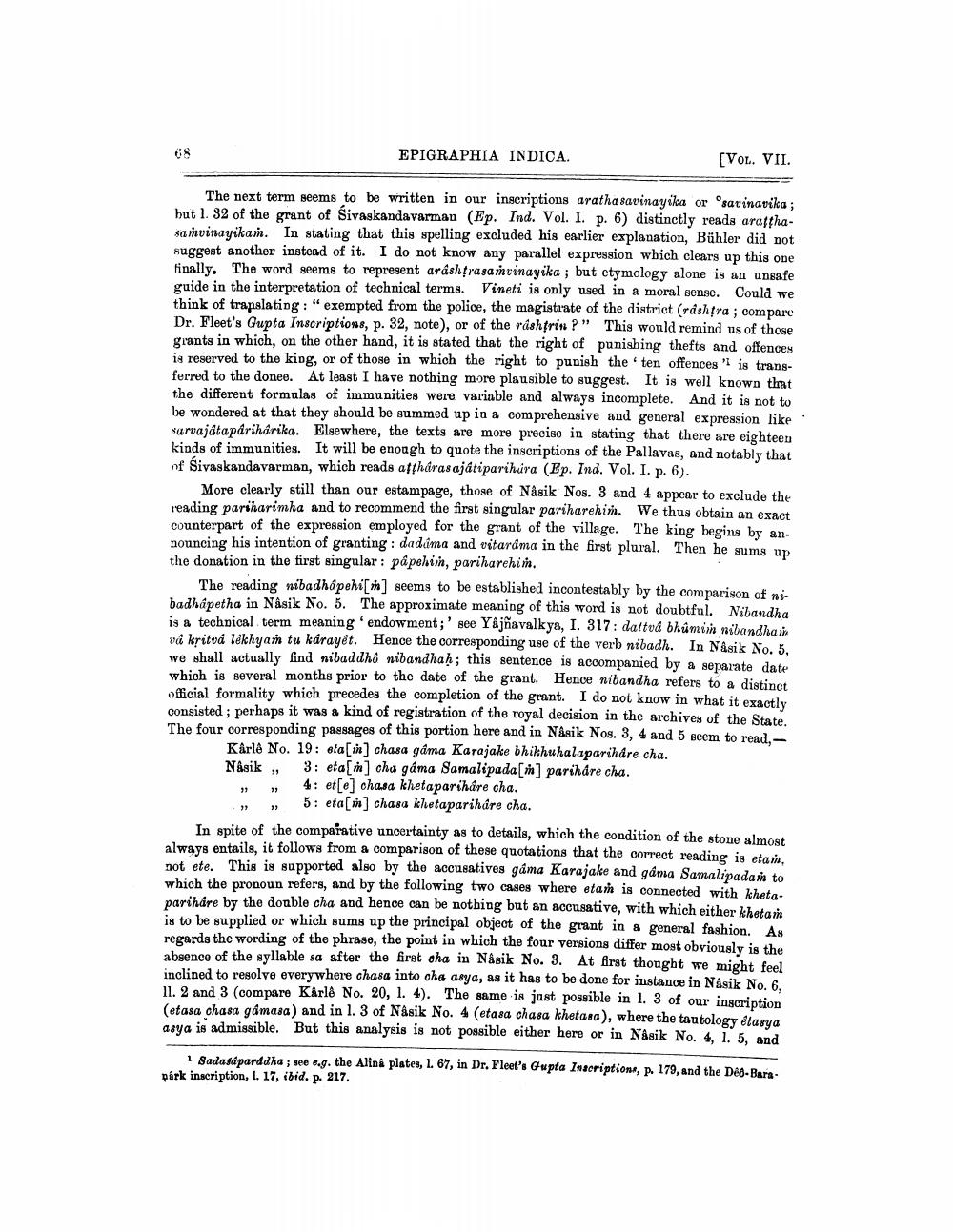________________
EPIGRAPHIA INDICA.
[VOL. VII.
The next term seems to be written in our inscriptions aratha savinayika or savinavika ; but l. 32 of the grant of Sivaskandavarman (Ep. Ind. Vol. I. p. 6) distinctly reads aratthasamvinayikam. In stating that this spelling excluded his earlier explanation, Bühler did not suggest another instead of it. I do not know any parallel expression which clears up this one finally. The word seems to represent arashtrasamvinayika ; but etymology alone is an unsafe guide in the interpretation of technical terms. Vineti is only used in a moral sense. Could we think of trapslating: "exempted from the police, the magistrate of the district (rashtra ; compare Dr. Fleet's Gupta Inscriptions, p. 32, note), or of the ráshtrin ?" This would remind us of those grants in which, on the other hand, it is stated that the right of punishing thefts and offences is reserved to the king, or of those in which the right to punish the 'ten offences' is transferred to the donee. At least I have nothing more plausible to suggest. It is well known that the different formulas of immunities were variable and always incomplete. And it is not to be wondered at that they should be summed up in a comprehensive and general expression like sarvajataparihárika. Elsewhere, the texts are more precise in stating that there are eighteen kinds of immunities. It will be enough to quote the inscriptions of the Pallavas, and notably that of Sivas kandavarman, which reads afphdrasajátiparihúra (Ep. Ind. Vol. I. p. 6).
More clearly still than our estampage, those of Nâsik Nos. 3 and 4 appear to exclude the reading pariharimha and to recommend the first singular pariharehin. We thus obtain an exact counterpart of the expression employed for the grant of the village. The king begins by announcing his intention of granting : dadama and vitaráma in the first plural. Then he sums up the donation in the first singular: papelvin, pariharehi n.
The reading wibadhápehi[m] seems to be established incontestably by the comparison of nibadhápetha in Nasik No. 5. The approximate meaning of this word is not doubtful. Nibandha is a technical term meaning endowment;' see Yajñavalkya, I. 317: daltva bhúmin nibandhan vå kritvå låkhyarh tu kårayet. Hence the corresponding use of the verb nibadh. In Nasik No. 5, we shall actually find nibaddhô nibandhaḥ; this sentence is accompanied by a separate date which is several months prior to the date of the grant. Hence nibandha refers to a distinct official formality which precedes the completion of the grant. I do not know in what it exactly consisted ; perhaps it was a kind of registration of the royal decision in the archives of the State. The four corresponding passages of this portion here and in Nâsik Nos. 3, 4 and 5 seem to read. -
Kårld No. 19: sta[] chasa gama Karajake bhikhuhalapariháre cha. Nasik, 3: eta[m] cha gama Samalipada[m] parihdre cha.
4: et[e] chasa khetapariháre cha. » 5: eta[rn] chasa kletaparihare cha. In spite of the comparative uncertainty as to details, which the condition of the stone almost always entails, it follows from a comparison of these quotations that the correct reading is etan. not ete. This is supported also by the accusatives gáma Karajake and gama Samalipada na to which the pronoun refers, and by the following two cases where etam is connected with khetaparihare by the double cha and hence can be nothing but an accusative, with which either khetan is to be supplied or which sums up the principal object of the grant in a general fashion. As regards the wording of the phrase, the point in which the four versions differ most obviously is the absence of the syllable sa after the first cha in Nâsik No. 3. At first thought we might feel inclined to resolve everywhere chasa into cha asya, as it has to be done for instanoe in Nasik No. 6. 11. 2 and 3 (compare Kårlê No. 20, 1. 4). The same is just possible in 1. 3 of our inscription (etasa chasa gamasa) and in 1. 3 of Näsik No. 4 (etasa chasa khetara), where the tautology tasya asya is admissible. But this analysis is not possible either here or in Nasik No. 4, 1. 5, and
1 Sadasparddha; see e.g. the Alina plates, 1. 67, in Dr. Fleet's Gupta Inscriptions, p. 179, and the De-Bara park inscription, 1. 17, ibid. p. 217.




